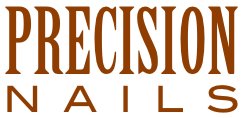Article Published in Stylist Magazine, May 2012
Browsing the home page of msnbc.com recently, I was surprised to find an article link containing the words "extreme manicure" at the top of the page. Before proceeding to the article, I hesitated a moment. Whenever reading or watching any news related to nails, I'm prepared to be disappointed and frustrated. It's not that I expect the news to be positive; that would be remarkable and promising, and likely not news at all.
There's a difference between journalism (investigating and reporting on current events, trends, etc.) and content marketing (providing information to alter consumer behavior and build brand loyalty). I expect journalistic integrity from my news, and hold the media accountable for what they present. What's the purpose and relevance of the news report? Who's the source? Is the information (facts, quotes, etc.) accurate and objective? Has the context been adequately established? What are the qualifications of any contributors? How was the research conducted? What conclusions can be drawn? What impact does the information have? And on a more personal note, why should I care?
Some defend content marketing by claiming that consumers are sophisticated enough to distinguish between journalism and marketing: "today's audiences are accustomed to filtering information from a great many sources and taking those sources into account" (When Worlds Collide by Peter Haapaniemi at www.customcontentcouncil.com). Really? If I were a consumer without any specialized knowledge about nail care (anatomy/physiology, infection control, product chemistry, etc.), I'd probably believe the following:
- nails need to breathe;
- clients should bring their own tools to the salon;
- professional nail services, pedicures in particular, can be deadly;
- nail polish adversely affects reproductive health and causes breast cancer;
- UV lamps used to cure gel nails cause skin cancer;
- products that smell are more toxic than ones that don't.
If having your nails done is dangerous, then doing nails must be very dangerous. Yet, manicurists don't even make the list of "The 15 Most Dangerous Jobs in America:"
- Fishers and related fishing workers*
- Logging workers
- Aircraft pilots and flight engineers*
- Farmers and ranchers*
- Coal miners
- Roofers
- Refuse and recyclable material collectors*
- Truck drivers*
- Police officers*
- Electrical power-line installers and repairers
- Construction laborers
- Taxi drivers and chauffeurs**
- Grounds maintenance workers*
- Athletes, coaches, umpires and related workers*
- Operating engineers and construction equipment operators*
** Assaults accounted for slightly more deaths than transportation incidents.
(Based on data compiled by the Bureau of Labor Statistics in 2010 and reported by Gus Lubin and Kevin Lincoln for www.businessinsider.com).
My work as a nail professional does not require driving, which might explain why it doesn't rank among these other professions.
That being said, it's interesting that when I Googled "nail polish death," I could document an actual death related to nail polish. But it had nothing to do with "toxic" chemicals as some might expect In a tragic incident widely known as the "Nail Polish Crash," motorcyclist Anita Zaffke was killed by motorist Lora Hunt who was polishing her nails while behind the wheel. Hunt was subsequently convicted of reckless homicide and sentenced to 18 months. Meanwhile, Zaffke's son Greg honors his mother's memory with the Crash Coalition (www.crashcoalition.org), a non-profit organization advocating against DWD (driving while distracted). DWD is deliberate and avoidable, yet one of the the leading causes of fatalities and injuries according to the National Highway Traffic Safety Administration (www.distraction.gov.).
I digress, so back to the article I found on msnbc.com, A whole new gloss: Consumers buy into 'extreme manicure' trend by Martha C. White. The author and I have different perspectives on what constitutes "extreme" or even "new;" she briefly mentions the "crack" polish look and "press-on decals" as if they were revolutionary. Within approximately 400 words, the word "bright" appears 3 times to emphasize the trend towards bolder and less traditional colors. White also cites some research from the NPD Group about increased polish sales at department stores (up 63%) and the popularity of blue polish, which accounts for 20% of the top 130 colors sold. (There's no data included on polish sales at salons or mass market retailers, like Target or Walmart.)
White concludes that "budget-minded," "DIY" shoppers are driving this "low-cost trend." That's laughable because I would never refer to consumers who buy department store polish as "budget-conscious" or likely to DIY; Chanel's Le Vernis Nail Color, at $26 a bottle, is hardly "low-cost" when compared to professional polish available for about $8 a bottle. So while the overall tone of the article is positive (no mention is made of the "toxicity" of nail polish ingredients), White ends her article by quoting a retail strategist: '"The customer that used to to get weekly manicures is probably doing her own nails," Levy said. That nail salon's loss is a beauty retailer's gain.' Here's some news: we're gaining clients who prefer to have their nails done professionally, and we also retail polish, some of it blue.
By Jaime Schrabeck, Ph.D.




